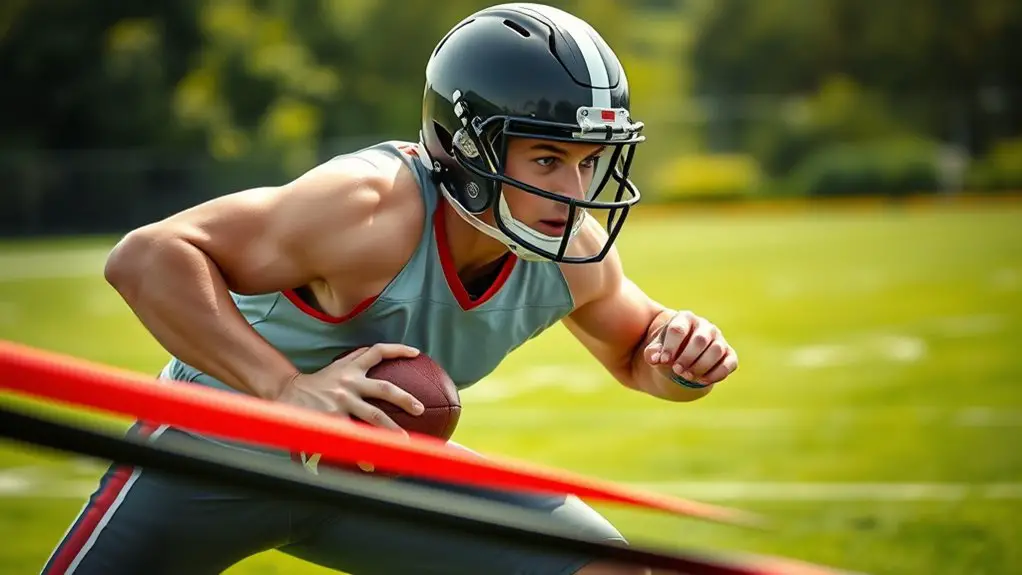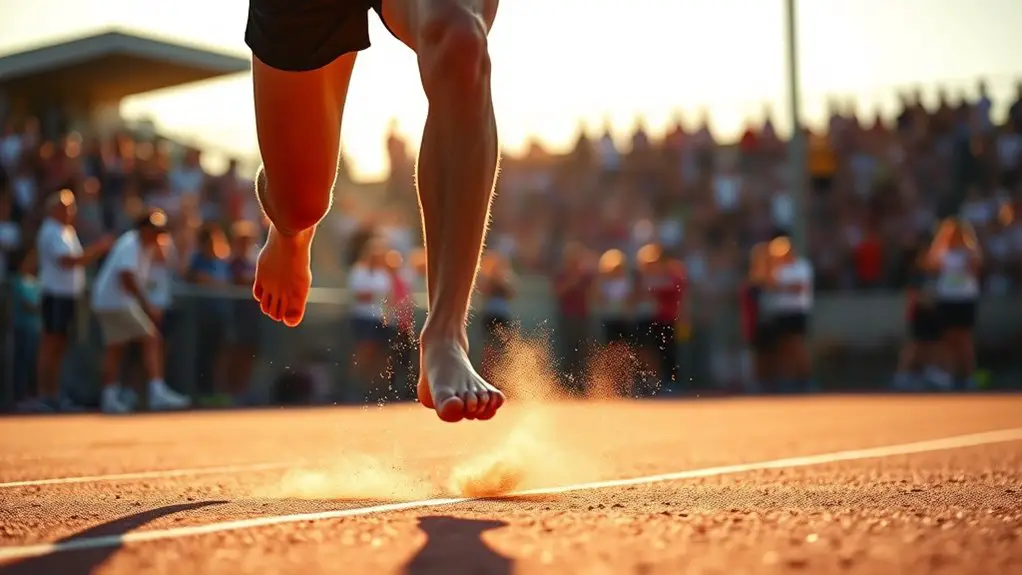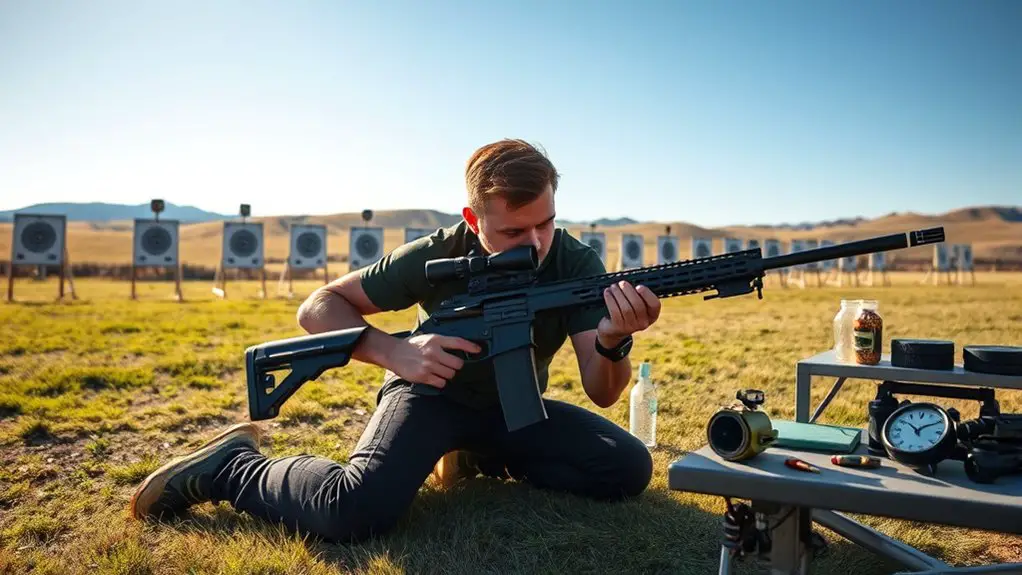Glute activation is critical for sprinters since strong glutes serve as the primary engine for speed and power. Engaging your glutes stabilizes your hips, improving your form and reducing injury risk. Proper activation enhances acceleration and stride length while minimizing wasted energy, allowing for more efficient sprinting. Ignoring this essential muscle group can result in slower times and increased reliance on weaker muscles. Keep exploring to discover more about maximizing your sprinting potential.
Understanding the Role of the Glutes in Sprinting
When you sprint, your glutes play an essential role in driving power and speed. These powerful glute muscles are your body's primary engines, propelling you forward with each stride. When you engage your glutes effectively, you improve your sprint mechanics, allowing for a more efficient and explosive run. By harnessing the strength of these muscles, you'll not only enhance your speed but also reduce your risk of injury.
Think about it: strong glutes stabilize your hips, which is vital for maintaining form as you accelerate. If your glutes aren't activated properly, you might rely on other muscles, leading to fatigue and inefficiency. Focusing on glute engagement during your workouts can reveal greater freedom in your movements. When you understand their role, you'll find that sprinting becomes not just a physical activity, but a liberating experience that connects your body and mind in powerful ways. Additionally, incorporating glute activation exercises into your routine can further enhance your performance and prevent injuries.
The Science Behind Glute Activation
Although many athletes underestimate the importance of glute activation, scientific research underscores its critical role in optimizing performance and preventing injuries. The glute anatomy, which includes the gluteus maximus, medius, and minimus, plays a pivotal part in sprinting mechanics. When these muscles are properly activated, they contribute to explosive power, stability, and efficient movement patterns. Core strength acts as the foundation of athletic performance, enhancing the effectiveness of glute activation and overall sprinting ability. Neuromuscular activation refers to the communication between your nervous system and muscles, ensuring that your glutes fire effectively during sprints. This connection enhances your ability to generate force, helping you propel forward with speed and agility. Without proper activation, you might rely on less powerful muscles, leading to inefficiencies and increasing the risk of injury.
Common Mistakes Sprinters Make Regarding Glute Activation
Many sprinters overlook the importance of proper glute activation, leading to several common mistakes that can hinder performance. You might find yourself stuck in a cycle of poor posture and inadequate warm-ups, which can limit your potential. Neglecting core strength and relying too much on your quads can create imbalances, while improper technique may lead to inefficient strides.
Here's a quick overview of these mistakes:
| Common Mistake | Emotional Impact | Performance Effect |
|---|---|---|
| Poor Posture | Frustration | Decreased speed |
| Inadequate Warm-up | Anxiety | Higher injury risk |
| Neglecting Core | Disappointment | Reduced power |
| Over-reliance on Quads | Confusion | Loss of speed |
Addressing these issues won't just improve your sprint; it'll help you experience the freedom of true athletic performance. Remember, consistency is key! Additionally, ensuring proper glute activation can enhance your overall strength and stability, which are vital components of functional strength training for athletes.
Benefits of Strong and Activated Glutes
Strong and activated glutes play an essential role in a sprinter's performance. When your glute strength is optimized, you'll notice a significant boost in your sprint mechanics. This means improved acceleration, enhanced stride length, and increased power output. Imagine feeling that freedom as you sprint with greater efficiency, pushing through each stride with confidence.
Activated glutes stabilize your pelvis and lower back, reducing the risk of injury and allowing you to maintain your form even at high speeds. The connection between glute strength and explosive power can't be overstated; it's the foundation that supports your entire movement. With strong glutes, you can release your full potential, feeling the thrill of speed as you fly down the track. Additionally, incorporating plyometric exercises into your training can further enhance your explosiveness and overall leg power.
Exercises to Enhance Glute Activation
To maximize your sprinting performance, incorporating specific exercises that enhance glute activation is essential. Firing up your glutes will not only improve your speed but also reduce injury risk. Here are some effective exercises to take into account:
| Exercise | Description | Frequency |
|---|---|---|
| Banded Bridges | Use a resistance band to activate glutes while lying on your back. | 3 sets of 10-15 reps |
| Hip Thrusts | Elevate your shoulders and thrust your hips upward for maximum contraction. | 3 sets of 10-15 reps |
| Single Leg Deadlifts | Balance on one leg while lowering a weight to engage your glutes. | 3 sets of 8-12 reps per leg |
| Clamshell Exercises | Lie on your side and open your knees against resistance to strengthen your glutes. | 3 sets of 10-15 reps |
| Kettlebell Swings | Swing a kettlebell to activate your glutes and improve power. | 3 sets of 15-20 reps |
Incorporating these exercises can significantly enhance your overall strength and help you feel the difference in your sprints!
Incorporating Glute Activation Into Your Warm-Up Routine
Incorporating glute activation into your warm-up routine can greatly enhance your sprinting performance. Start with glute bridges to fire up those muscles. Lie on your back, knees bent, and lift your hips while squeezing your glutes at the top. This simple move helps you connect with your body and prepares you for explosive sprints.
Next, blend in dynamic stretches like leg swings and high knees. These not only loosen up your hip flexors but also engage your glutes, setting the stage for powerful strides. Don't rush—take your time to feel each stretch and activation. Additionally, focusing on the stretch-shortening cycle enhances your ability to generate explosive power during your sprints.
The Connection Between Glutes and Sprinting Speed
Your glutes play an essential role in generating power during sprints, allowing you to push off the ground with force. When activated properly, they help transfer that force efficiently through your body, maximizing your speed. Understanding this connection can greatly improve your sprinting performance. Additionally, developing functional strength through compound movements is vital for enhancing your glute activation and overall sprinting ability.
Power Generation
Releasing sprinting speed hinges on effective power generation, and the glutes play a pivotal role in this dynamic. When you activate your glutes, you're tapping into a powerhouse that enhances sprint mechanics. This activation fosters muscle synergy, allowing your body to work as a cohesive unit for explosive speed. Your glutes provide the necessary force to propel you forward, engaging the hamstrings and quads in harmony. By focusing on glute activation, you can maximize your acceleration and maintain velocity throughout your sprint. This connection isn't just about strength; it's about freedom in movement. So, embrace the power of your glutes, and watch your sprinting efficiency soar as you break free from limitations and release your true potential.
Force Transfer
While sprinting, the ability to transfer force efficiently is essential, and the glutes serve as the primary engine for this process. When you engage in proper force transfer techniques, your glutes activate powerfully, allowing you to propel forward with speed and agility. This connection is significant for achieving biomechanics efficiency, as it minimizes wasted energy and maximizes acceleration. If your glutes aren't firing correctly, you'll struggle to harness your full potential, leading to slower times and increased fatigue. By focusing on glute activation, you'll enhance your ability to transmit force through each stride, releasing your body's natural freedom to sprint faster. Ultimately, mastering this connection can transform your performance on the track.
Injury Prevention Through Glute Activation
When you activate your glutes, you enhance hip stability, which is essential for maintaining proper sprinting form. This improved stability leads to better force production, helping you maximize your speed while minimizing the risk of injury. By focusing on glute activation, you're setting yourself up for safer and more effective training sessions. Additionally, strong and flexible hamstrings contribute to reducing injury risk, further supporting your sprinting performance.
Enhanced Hip Stability
Glute activation plays a crucial role in enhancing hip stability, which is essential for preventing injuries during sprinting. When you engage your glutes, you not only improve hip mobility but also promote core engagement, creating a solid foundation for powerful strides. This stability allows you to maintain proper form, reducing the risk of strains and sprains.
| Benefits | How It Helps | Tips for Activation |
|---|---|---|
| Improved Balance | Reduces injury risk | Perform glute bridges |
| Enhanced Mobility | Allows freer movement | Incorporate dynamic stretches |
| Core Strength | Supports hip function | Engage core during exercises |
Improved Force Production
Effective force production is essential for sprinters, as it directly influences speed and power. When your glutes are activated, you're not just enhancing muscle coordination; you're also maximizing your force application with every stride. This means you can push off the ground more effectively, translating that energy into forward momentum. Without proper glute activation, you risk inefficient movement patterns that can limit your performance. By focusing on engaging your glutes, you guarantee that your body can generate the strength needed for explosive sprints. This not only boosts your speed but gives you the freedom to run with confidence, knowing you're harnessing the full potential of your muscles. Embrace glute activation, and watch your performance soar.
Reduced Injury Risk
While sprinting demands explosive power, it is crucial to remember that injury prevention is equally important. By focusing on glute recruitment, you can enhance muscle coordination, reducing your risk of injury. When your glutes are activated, they stabilize your pelvis and spine, allowing for better alignment and movement patterns. This means less strain on your knees and lower back, which are often vulnerable during high-intensity sprints. Strong, well-coordinated glutes help distribute forces more evenly throughout your body, making you less susceptible to common sprinting injuries. So, prioritize glute activation in your training. It's not just about speed; it's about staying injury-free and enjoying the freedom to push your limits on the track without fear.
Real-Life Examples of Successful Sprinters and Glute Focus
Many elite sprinters attribute their success to the strength and activation of their glutes, showcasing how essential these muscles are for explosive power and speed. Take Usain Bolt, for instance; his incredible glute training success has been pivotal in achieving world records. By focusing on glute activation, he maximizes his stride length and accelerates faster than anyone else. Similarly, Florence Griffith-Joyner, another elite sprinter example, incorporated targeted glute workouts into her routine, helping her dominate in the late '80s.
You can see how these athletes harness their glutes to release their full potential. When you prioritize glute activation in your training, you're not just building muscle; you're setting yourself up for freedom on the track. Emulating the techniques of these sprinters can lead to your own success, proving that strong glutes are the foundation for speed and power in sprinting. Furthermore, incorporating exercises like squats and lunges can significantly enhance your glute strength and overall athletic performance.
Frequently Asked Questions
Can Poor Glute Activation Lead to Other Muscle Imbalances?
Yes, poor glute activation can definitely lead to muscle imbalances. When your glutes aren't firing properly, other muscles step in to compensate, disrupting your body's natural mechanics. This can reduce your biomechanical efficiency, making movements feel less fluid. You might find yourself struggling with strength or stability, limiting your freedom of movement. By focusing on glute activation, you can restore balance and optimize your performance, allowing for a more liberated and powerful motion.
How Long Does It Take to Improve Glute Activation?
Think of your glutes as the engine powering your freedom to sprint like the wind. Improving glute activation can take a few weeks to a couple of months, depending on your training frequency and consistency. If you commit to regular strength training and focus on those glute-targeted exercises, you'll notice gains in no time. Just remember, it's not a sprint; it's a journey to release your true potential!
Are There Specific Diets That Support Glute Activation?
Absolutely, there are specific diets that can support glute activation. You'll want to focus on glute-friendly foods, like lean proteins, healthy fats, and complex carbs. Incorporating these into your meals can help fuel muscle growth. Don't forget about nutrient timing; eating the right foods before and after workouts can make a big difference. Enjoy the freedom to experiment with different combinations that make you feel energized and ready to activate those glutes!
Can Glute Activation Exercises Be Done at Home?
Like a bird spreading its wings, you can soar with freedom in your home workouts! Yes, glute activation exercises can definitely be done at home. Simple moves like bridges, squats, and lunges require no special equipment and can be easily incorporated into your routine. These glute exercises not only strengthen your muscles but also enhance your overall fitness, giving you the freedom to train whenever and wherever you want. So, get started today!
What Are the Signs of Weak Glutes in Sprinters?
If you're noticing a lack of power or speed during your sprints, it could be a sign of weak glutes. You might struggle to maintain form, feel excessive strain in your lower back, or have difficulty pushing off the ground effectively. These issues directly impact your sprint performance. Improving your glute strength can release your potential, allowing you to move freely and confidently, pushing past your limits and achieving your goals.




